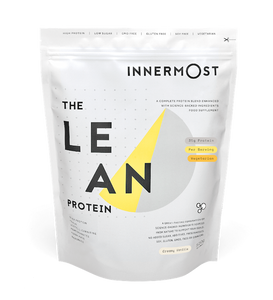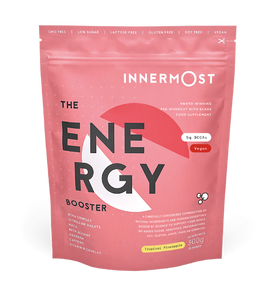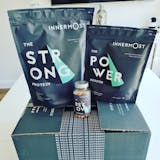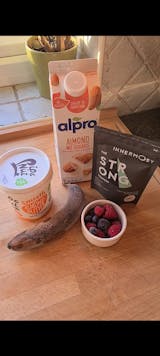We’ve all been there. You go for a hard workout, pushing yourself as far as you can and … by the end your reward is a new personal best and a series of aching muscles (or worse an injury). In these scenarios, it can feel frustrating. After such an exercise high, the first thing you want to do is to beat your record again and yet you’re now stuck with the muscle pain wondering how long it will take to heal.
The fact is that regardless of an individual’s workout experience, sport recovery is fundamental to muscle repair. While there are many ways to speed up the recovery process like taking our Innermost Recover Capsules or slowly rebuilding the muscles through light walks, most of us frequently neglect the most important form of recovery which is adequate sleep. While one-night of low sleep alone won’t impact long-term recovery, figures show that 77% of adults are not sleeping the recommended 8 hours a day and as many as 18% sleep less than 6 hours. As we’ve previously written about the benefits that exercise can have on sleep, we feel its only fair to highlight the importance that sleep has on workout recovery.
Why is sleep so important in recovery?
As frustrating as it can be, it’s nigh-on impossible to quickly recover from muscle pain and continue to smash those PBs without adequate rest. While getting a good amount of sleep can seem like a small afterthought (perhaps even a luxury) when we have to fit it around our busy lives, a decent night’s rest is where the body is best at recovering the soft and neural tissues after an intense workout. But just why is that? How is it your body heals faster during sleep and what is the science behind it?
-
Increased Blood flow
Interestingly, this occurs during Non-Rem Stage 3 of the sleep cycle in which the body is in the deepest part of sleep. During this stage the body priorities the repairing and regrowth of body tissue, as well as building bone and muscle (sounds like a good exercise-recovery plan to me). While it might seem like it should be the opposite, the faster recovery can largely be attributed to the increased blood flow and therefore greater flow of oxygen and nutrients to the damaged muscles during this sleep stage.
-
Recovery Hormones
A well-rested sleep - in line with the internal body clock - also plays a part in the production and regulation of several hormones that stimulate muscle recovery. During the deep stages of Non-REM sleep for instance the pituitary gland aids in the repairing of muscles through the release of growth hormones. Evidence also shows that a well-rested night contributes to improved performance and pain sensitivity as the hormone prolactin – released during this process – regulates muscle inflammation and allows the body to heal itself effectively.
-
Faster reflex times
Another perhaps overlooked benefit of sleep on an individual’s recovery are the improvements to cognitive response it can bring during the muscle rehabilitation process. A faster reflex time is a good example of this. In truth, during a light workout after injury the last thing you want to do is put unwanted pressure on a muscle. An improved reflex time allows an individual to react faster and with clearer judgment to any potential hazards and avoiding a recovery setback through injury inflammation.
-
Improved Mental Wellbeing
We know we’ve mentioned this before, but a key benefit of exercise is the positive impact it can have on mental wellbeing – thanks to our good endorphin friends serotonin and dopamine. That’s just another reason why recovering from any injury can be a tough challenge; you lose the elation of a phenomenon like runners high and suddenly, your mood can begin to dip. Getting into the routine of a good night’s sleep can actually contribute to improved mental clarity and wellness. This is because the brain’s ability to process positive emotional information is improved during REM - which occurs more frequently from longer sleep.
How to get the best possible sleep
While it’s true that a deep sleep is really important to recovering from injury, all this means nothing if you’re tossing and turning all night. To this end, there are a few changes surrounding sleep conditions that can vastly improve an individual’s quality of sleep.
Sleeping Comfort
The idea of comfort being tied to good sleep, who would have guessed? But you’d be surprised how often we take comfort for granted, especially during period of muscle fatigue or after an injury. While the Mayo Clinic recommends sleeping on your side to improve airway clearance, you should try and sleep in a position that best accommodates the muscle injury – the last thing anyone wants to do is to strain the muscle further during a night’s sleep. If you’re not sure on the best position to not further aggravate an injury, consider seeking advise from your doctor or a medical professional. It’s also a good idea to try and invest in a quality mattress that offers healthy pressure relief on injury pain points to better optimise sleep recovery.
Sleeping Environment
Often times, the environment with which we sleep in can be just as important as the bed itself in getting a good night’s rest and repairing the muscles. We’d recommend trying to create a restful, cool, and dark environment away from any reminders of day stresses. This does also mean not using your phone before going to bed – something we’ve all definitely been guilty of – as the light from the screen can disrupt the production of the hormone melatonin and disrupt the sleep cycle.
If you’re finding that you just can’t get good enough sleep, it can be a good idea to plan a sleep schedule each night based around how much rest you think you can get. This can also be tailored to the injury rehabilitation process to ultimately get the most out of sleep recovery. Essentially it’s about balance. Be kind, plan for the days you know you might have impacted sleep and try to avoid any rehabilitation exercises the next day.
How much sleep should I get?
The key question here; how much sleep is the right amount to speed up muscle recovery? While it’s recommended that you should aim for at least 7 to 9 hours per night depending on age, the exact time, speed, and extent of muscle repair varies greatly from person to person. For a more definitive answer, we’d recommend contacting your local physiotherapist – or general practitioner – who can give advice more tailored towards your specific injury and rehabilitation requirements.
At the end of all this, we hope this this will help with any current or future muscle injuries you may have. While it might seem strange, the recovery stage of a workout is arguably as important as an individual’s diet and perhaps even the exercise itself. To this end, it can be a good idea to think of the recovery as another stage of the workout process and sleep as the unexplored treasure that will help you smash the next PB.
Interested to learn more about workout recovery? Wondering on the best ways to fuel your next workout? Perhaps you have some amazing and inspired ideas to share? Don’t hesitate to message us over on our Instagram @liveinnermost.
























